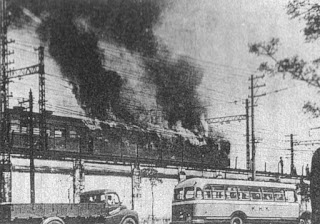Proceedings of the National Diet Hearing on the Sakuragicho Accident No. 1
First of all
I am not sure how much I can go into today, but I will start uploading the transcripts of the parliamentary inquiry into the Sakuragicho accident (the parliamentary inquiry of the driver, conductor, and electric power district at the time).
I hope to add as much commentary as possible, but this is my first time to do so, and I may only be able to leave a few notes.
Now, I would like to give you a brief overview of the Sakuragicho accident.
What kind of accident was the Sakuragicho accident?
Let me quote from our website "When Japan National Railways existed".
A Keihin Tohoku Line train caught fire at the Sakuragicho station of the Japan National Railways (JNR) in Yokohama on April 26.
At around 1:40 p.m., a down train (Moha 63, 5-car train 1271B) from Akabane on the Keihin-Tohoku Line was approaching the overhead wires 50 meters before the final Sakuragicho Station when it was discovered that the insulators had been accidentally cut and were hanging down during replacement work. The first car was burned to the ground and the second car was half-burned, resulting in 106 deaths and 92 people seriously injured.
The train in operation at the time was a Type 63 manufactured during and after the war.
Among the causes of the large number of fatalities in this accident were
- The lack of emergency door cock markings
- The windows were three-tiered to save glass and provide ventilation, but the middle tier was fixed, so the passengers could not escape out of the car through the windows.
- To prevent passengers from escaping through the ticket gates, each train did not have a through passage, and the doors between the doors were inward-facing, so they could not be opened in a crowded car.
- Because the trains were manufactured during the chaotic period of the war and the postwar period, they were extremely dangerous because of the omission of security parts, etc.
The above reasons were considered.
JNR announced countermeasures on the same day.
D cock (emergency door cock) was clearly marked.
Temporary entry to the factory was also made to install the throughpass and replace it with a standard part.
Parliamentary hearing by the driver of the day
When the train was about to enter the up line, there was a big spark like thunder, and I thought this was a big problem, so I immediately applied emergency braking to stop the train, and at the same time I lowered the pantograph. At the same time, the pantograph was lowered. Even though the pantograph was lowered, sparks still appeared. The fire could not be extinguished no matter how long the fire was extinguished. Normally, the fire would be extinguished by lowering the pantograph, but the sparks kept coming out and the fire was not extinguished.
When I looked at the ceiling of the train, I saw flames rising.
He also testified that he looked back and saw flames coming from the ceiling.
He further testified that he tried to take steps to get the passengers off the train.
I knew then that I had to get the passengers out of there right away. I thought I had to make arrangements to open the door again, and I used the string to raise the pantograph, but in the end, the pantograph was stuck and I was in a half-sitting position, so I don't know exactly what happened. I am not sure if the solenoid valve that raises the pantograph was handled or not. I think the conductor switch was opened immediately after that. At the same time as the conductor switch was opened, a drum switch was also opened, but it is not clear which of the two switches was used.
The driver testified that there was nothing wrong with the overhead line he was driving on, and that he saw the overhead line hanging down on the side of the train.
The tragedy occurred as he tried to enter the up line from the down line.
The Keihin Tohoku Line (Keihin Line) at that time terminated at Sakuragicho, and when it tried to transfer to the up line, it became entangled in the drooping trolley line, and naturally, the down line had no problem, and the up line trolley line was cut about 50m before the up line, and when it transferred and entered the up line The driver of the down line never dreamed that the trolley line would become entangled in the pantograph of the lead car, and the exchange between the two was also recorded.
Please see below.Mr. Shinoda: So the slack overhead line passed through?
Mr. Nakamura: No, there is nothing wrong with my line at all.
Mr. Shinoda: But didn't you pull the pantograph over the slack overhead wires?
Mr. Nakamura: Yes, that is correct.
Mr. Shinoda: So, when you came in, you saw the slack overhead wires here.
Mr. Nakamura: I did not recognize the overhead wire there.
Mr. Shinoda: So you were looking at the overhead wires going down over there. You did not know about the overhead wire here, did you?
Mr. Nakamura: I don't know that part. I thought there was nothing wrong with my view.
To be continued


コメント
コメントを投稿